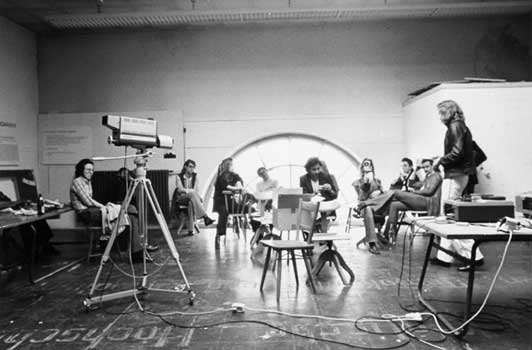Kunstakademie Düsseldorf
Düsseldorf was a culturally very active city from
the sixties. The major contribution of private enterprise and the great
organisational thrust of the artists themselves enabled the presentation
of the work of creators, not only from the local sphere of the visual
arts, but also from the international sphere and in different disciplines,
with the consequent exchanges of ideas and positions. That flowering found
a parallel in the institutional sphere, especially in the exhibitions
that were put on at the Kunsthalle and the activity carried out the Kunstakademie.
That art education centre was an exceptional case, one where teachers
and students came together, moved by a common interest in experiment and
discussion.
The encounter, from the mid sixties, of young students such as Jörg
Immendorf, Blinky Palermo, Reiner Ruthenberg, Katharina Sieverding and
Hans Peter Feldman and their contact with Daniel Spoerri, Dieter Roth,
Nam June Paik, Robert Filliou or Marcel Broodthaers was crucial for the
importance of the Academy of Fine Arts in the city as the crystallisation
of a large number of radical initiatives. For instance Gerhard Richter,
Sigmar Polke and Konrad Lueg spread a realistic notion of capitalism among
the other students, and in 1963 organised a legendary exhibition in a
furniture shop; and teachers such as Karl Bobek, Joseph Beuys or Ole John
were very active during the sixties and throughout the seventies.
Joseph Beuys was especially important; he established a very intense relation
with his students and an educational process in which they were directly
involved. He acted as an engine among the students, provoking confrontation
and struggle to the point where in 1971 he was officially expelled from
the Academy. His work on the power of art as a tool for raising awareness
and for liberation inspired a large number of people. Immendorf, who was
studying at the time, has often stressed Beuys’ influence, as well
as the political implications of his teaching practices
A few years earlier, at the end of 1968, Immendorf himself had been one
of the promoters of the LIDL group (in which Marcel Broodthaers, James
Lee Byars and Kasper König were involved, among others), the LIDL
Akademie and the LIDL Klasse at the Kunstakademie in Düsseldorf.
LIDL was a sign of identity which organised actions and protests of different
kinds, acting as an autonomous instrument of information and production.
Athena, Joseph Beuys online guide:
http://tizian.khi.uni-heidelberg.de/athena/3-3.html
Lucrezia De Domizio. Difesa della Natura, J. Beuys:. http://www.socialsculpture.org/ss_source/ss_html/ss_jb_natura.html
7000 Oaks. Joseph Beuys: http://www.diacenter.org/ltproj/7000/newtrees.html
Demarco European Art Foundation: http://www.dmcsoft.com/beuys/exh.html
Multiples, projecte al Walker Art Center: http://www.walkerart.org/beuys/

Film- und TheaterKlasse Kunstakademie
Düsseldorf, 1973
